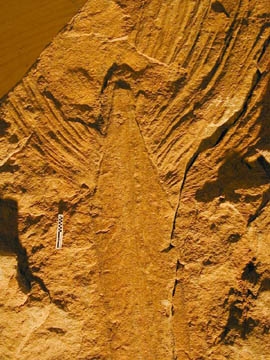 Paleontologist Kevin Aulenback gave a seminar at MBC entitled, “Conifers, Cycadeoids and Palms of the Horseshoe Canyon Formation, Alberta, Canada, with a new interpretation of fossil conifer leaf arrangement.” This presentation focused on the plants of the formation that link most closely with MBC’s living collection. Aulenback began discussing a fossil plant often interpreted as a true cycad, however, he presented a strong case for the actual identity of the plant as a cycadeoid in the order Bennettitales, which has a markedly different cone structure that distinguishes it from modern cycads.
Paleontologist Kevin Aulenback gave a seminar at MBC entitled, “Conifers, Cycadeoids and Palms of the Horseshoe Canyon Formation, Alberta, Canada, with a new interpretation of fossil conifer leaf arrangement.” This presentation focused on the plants of the formation that link most closely with MBC’s living collection. Aulenback began discussing a fossil plant often interpreted as a true cycad, however, he presented a strong case for the actual identity of the plant as a cycadeoid in the order Bennettitales, which has a markedly different cone structure that distinguishes it from modern cycads.
Kevin Aulenback studied MBC’s cycad and palm collections to gain insights into the connections between modern and fossil floras. He is a noted expert on the Cretaceous period flora and fauna of the extensive Horseshoe Canyon Formation (68-72 million years old) and is the author of the book Identification Guide to the Fossil Plants of the Horseshoe Canyon Formation(University of Calgary Press). This formation is known as a rich site for dinosaur and plant fossils.
Kevin also discussed other gymnosperms found in the formation, including ancient relatives of modern conifers. Because interpretation of fossil fragments of conifer shoots is often challenging, he used observations on living conifers to develop a theory of how leaf arrangement varies within and between plants. This provides insights that can clarify understanding of the structure of both modern and extinct conifers.
The presentation concluded with a discussion of a fossil discovery that constitutes the most northerly occurrence of a palm in North America. This palm shows affinities in leaf structure to the genus Sabal. Another fossil palm from a later period has been found in Alberta with affinities to Serenoa, and yet another formation has yielded fossil palm seeds. Although these had been thought to be related to Nypa, examination of MBC’s living Nypa collections convinced Aulenback that the fossil seeds are not related to modern Nypa.
The talk highlighted the importance of careful observation of living plants for an accurate understanding of fossil plants. This underscores the importance of living collections, such as those at MBC, for understanding both current and ancient plant diversity.
